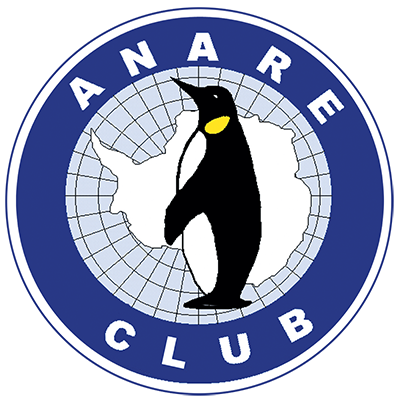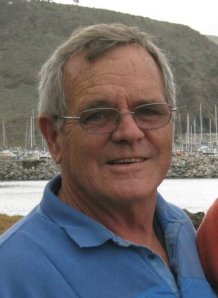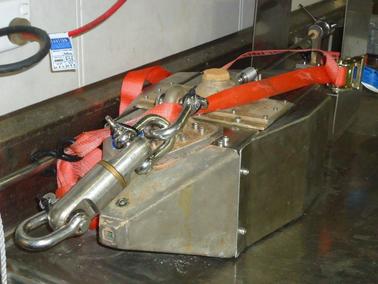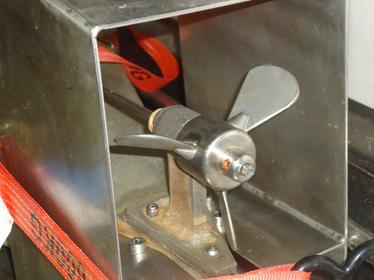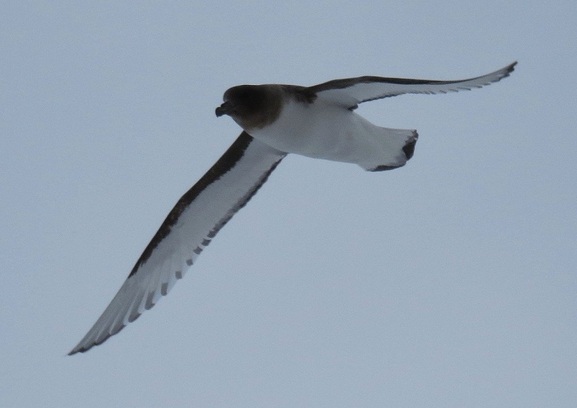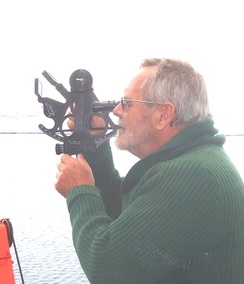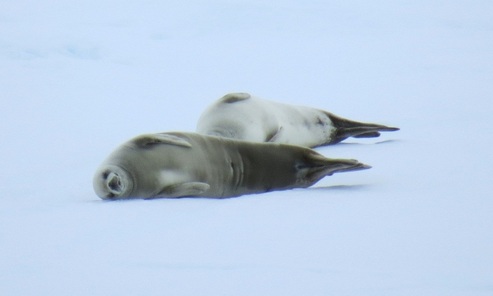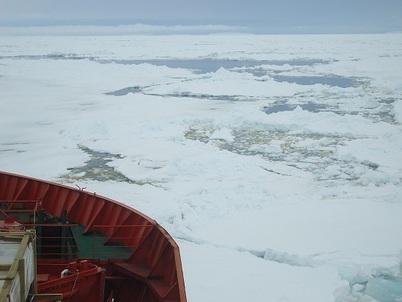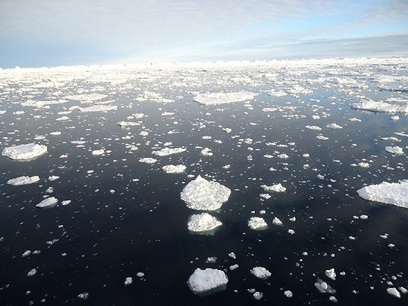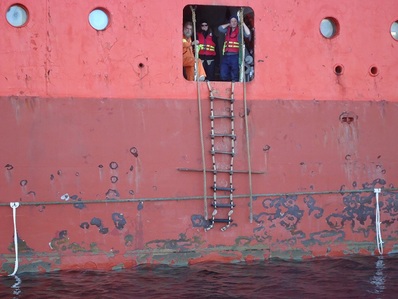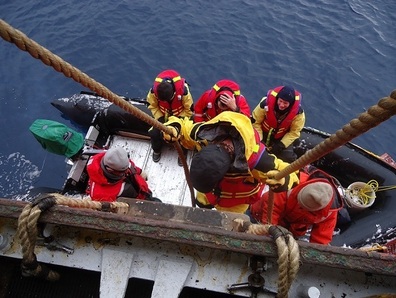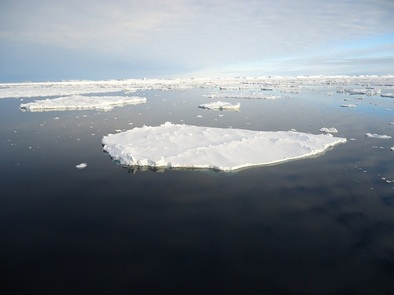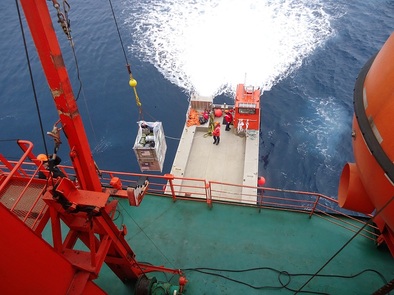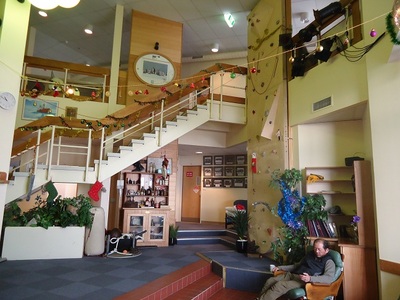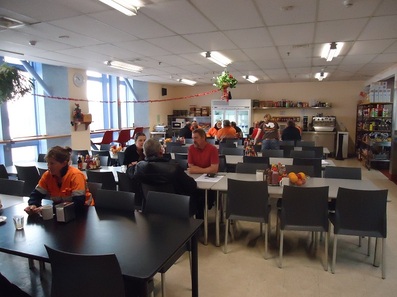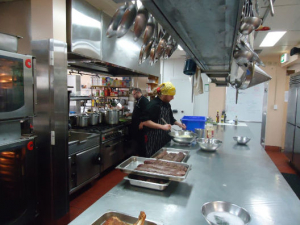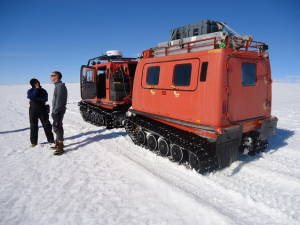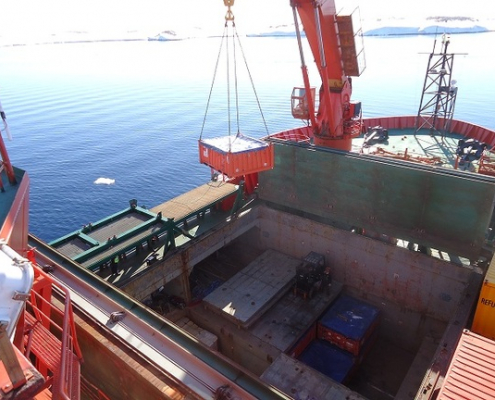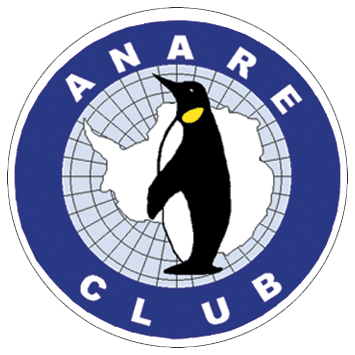Trevor Gadd ANARE Club Representatives 2012-2013
A voyage to re-supply Casey station for the 2013 year
As previous announced the Club has once again been awarded a berth on a voyage south this summer, largely to recruit new Club members from amongst the expeditioners. We are grateful as always for the generosity of the Division. The berth is on the Casey resupply voyage leaving on the17th December 2012 (V2) for the Casey resupply . The National Council of the Club has chosen long-serving member Trevor Gadd from South Australia to carry the flag on this occasion
17 Dec 2012
18 Dec 2012
19 Dec 2012
The weather has become a Macquarie Is like scene with misty rain and poor visibility. Wind is across the back starboard quarter and as a result we have picked up some speed to 10.5 knots. Late morning it was 1500nm to go. The iceberg sweep is up & running as we proceed south. Today Wandering Albatrosses flew around the boat for some time in the afternoon. They were adults but still very beautiful to watch. A large piece of bull kelp drifted past today reminding us that we are in the latitudes of Macquarie Island.
We had an illustrated talk tonight from Zane Hacker on a visit to Heard Island. The photographs were taken during what are very rare minutes of good weather. It was well attended. Those suffering from motion sickness all appeared to have recovered and Christmas decorations are now a feature of the mess.
Preparation for landing, unloading and resupplying of Casey are picking up in pace as the time approaches. With his unbridled authority Chris Galloway has changed Christmas day to Sunday the 23rd of December as we may well be unloading on the traditional day. Our weather man Abrar Shabren, tells us that there is a patch of clear skies ahead so here’s hoping he is right
The general tempo of the ships company is picking up.
20 Dec 2012
The weather and the sea have been very kind to us today and we have made good progress making some 275 nautical miles. The temperature is 3.5 degrees. Iceberg watching has begun but nothing seen. Great expectations are held by those whose choice of berg sighting date has yet to come.
The birds flying about the boat are not numerous but varied in type with albatrosses, shearwaters and prions being the most prevalent. We are approximately 1100 Nautical miles from Casey at 4pm with a current speed of just under 12 knots.
Courses have been run for all persons who will leave the ship on the distances that we are allowed to approach wildlife, specially incubating birds. We will also do a complete cleaning of any gear that we are taking ashore so as not to contaminate the local area with seeds, spores or other material.
The ship’s crew are setting up the ship for the ice environment, by protecting pipe work from freezing and checking equipment for the unloading task.
We had another interesting illustrated talk from Justin Febey, one of the watercraft operators, on the stranding of whales and what efforts and successes they have in Tasmania.
21 Dec 2012
We woke this morning to find a slightly lumpy sea but not a white cap in site, what a lucky trip so far! The sea continued in its passive mode all day, no icebergs seen yet, a sole penguin popped its head up but vanished too quickly for 100% identification, but probably an Adelie. At 8 am we took advantage of the calm weather to stop and do some repairs and took off again at 11am.
The major incident today was the initiation of those who had not crossed the 60 degree of latitude line. As with the changing of the Christmas Day celebration, our voyage leader, Chris, was able to manipulate the celebration of the 60th parallel to suit the needs of a working ship and crew. We the initiates were crowned with dead fish bespattered with pseudo vomit, and had to drink a foul mixture. The crew put much effort into the show dressing up as a tribunal chaired by King Neptune with trident in hand. Long showers were indeed allowed to clean up. A great time for the old hand photographers who had passed their initiation on previous trips. The calmness of the ocean is amazing to see and a blessing to those who do not suffer it’s movement well.
Our journey south is going well with our Lat being S 55.02 & L 129.2 E travelling about 13 Knots and about 820 Miles from our approach to Casey waypoint. At the moment we have less than 4 hours of darkness.
22 Dec 2012
Our gentle cruise through the Southern Ocean continued making the deck drill this morning an easy event.
Tours of the engine space and the various machines for steam, waste disposal, water making, propulsion and steering systems were conducted by the ship’s engineering staff. This world beneath our passenger quarters was an amazing collection of sites. The control of the ship and its systems especially as a non-polluting vessel, are first class and it gave us a great deal of comfort to know we are in such capable hands. Working in these cramped conditions amongst moving machinery must be amongst the most dangerous – especially in a violently rolling and pitching ship.
At 4pm today we had achieved a record run of 308 nautical miles and we are travelling at 12.5 knots. Winds are ok at 18 knots and we are only 500 nautical miles from the way point. The large iceberg that was close to being in our way has moved further east so we should not be bothered by it. The size of that iceberg is 18 nm long and 5nm wide!
Tonight, the talk from David Pryce was on the re-enactment of the Bligh open boat trip from the mutiny site on the Bounty to Indonesia. This historic voyage was completed in only 2 hours more than Captain Bligh. An excellent presentation.
23 Dec 2012
Today the expeditioners and crew were treated to a Christmas spread that one could only dream about, less afford. The efforts of the catering crew once more had to be seen to be believed, their efforts were first class and well appreciated. Much celebration by us all including a modified Christmas song specially composed, although the tune had a familiar ring. A person resembling a well known and colourful visitor at Christmas times handed out presents to each and a great time was had by all.
A continuing parade of the most extraordinary icebergs passed us by with none looking just like any other. Even as we passed these monsters their shapes continued to amaze us. As views changed so did shapes. The digital camera at least allows us the technology to select and edit on the spot
We are now 196 nm from our next waypoint prior turning into Casey Base on the 25th of December. Our 4pm position is 61.52 S 114.52 E. we are doing about 13 kts. We should reach the edge of the ice pack tomorrow morning.
We are all off for an early night tonight
24 Dec 2012
Today at 1745 hrs is the 25th anniversary of the scuttling of the Nella Dan . Our day was in bright sunshine across an ever thickening patchwork of sea ice. By 1800 hrs the sea ice was virtually 100% cover. The inertia of the ice was enough to slew our ship away from its point of steering many times. Our helmsman had a job to constantly seek out less thick ice so as not to reduce our speed but also to maintain a reasonable course. Within the sea ice were numerous icebergs mostly well eroded into spectacular shapes and providing the photographers with plenty of opportunities to take pictures. As the ice broke away from the ship quite a bit of green and brownish algae was seen. Quite a few seals were spotted resting on the ice in the bright sunshine. It was most likely they were Crab-eaters. Some moved quickly to plunge into the water whilst others merely looked and went back to the resting pose. Penguins were also spotted and as with the seals some ignored us while others made their watery escape.
Preparations continue made for our unloading activities including what goes ashore first, who goes with it and when. All of this traffic has to be coordinated along with getting about a million litres of fuel ashore without spilling a drop.
Tonight looks like being the last night for the Casey wintering party on this ship. They have been a great group of shipmates and we wish them well for the coming year.
Due to the thickening ice our progress has been slowed significantly. Today at 6 pm we had travelled 225 nm and our current speed bulldozing our way through the pack is down to about 6 kts. We are now only 93 nm from Casey station. The water temperature is minus 2 and the air temperature is zero.
Our position is 64.53 S 109.36 E
25 Dec 2012
Today was a day 50 metres forward and 200 metres backward, all day, or that is what it seemed to be. Our path on the chart plotter shows the affect of the ice on the vessel. Some ice was thick, some was soft but mostly it was just in the way. From 9am to 4 pm we made 10 nm.
It is believed that about 12 nautical miles ahead we will reach open water again, which should please the helmsman no end. Life on board is in a type of suspended animation, all are primed for the complex tasks of getting fuel and the key operators all ashore to talk to their opposite numbers in preparation for taking over the station. Following that will be the unloading of general cargo and other personnel. Although this was part of our plan for today it is waiting for, hopefully tomorrow.
The number of penguins about on the ice as we approach seems to be increasing. What must we look like this giant red block that moved gently forward, shuddered, then retreated in order to do it all again. By later in the afternoon the ice, whilst looking thick and dense began to show signs of weakness and our speed picked up a little. The lurching to either side was still evident as 8500 tons of steel was resisted by the sea ice.
The wind is light and at 4 pm our position was 65.12 S and 109.5 E Temp about 0C
We all look forward to reaching our destination sometime tomorrow.
26 Dec 2012
By 1am we were well into the most beautifully lit, deep blue, mill pond calm sea scattered with small rafts of sea ice. In the distance some large tabular bergs embedded in the sea ice were seen. It was strange that at that hour so many people, including crew members, were taking advantage of the view.
By 7.45 am we were at our destination. The scattered buildings of Casey station were clearly visible along the skyline. We anchored and the well planned activities began with the unloading of the barge and the slinging aboard of the first container. The inflatable boats hurried across the harbour carrying the essential staff for the beginnings of the important handovers. This activity continued all day in a very light breeze and mostly sunny conditions.
For some today the pace was hectic whilst for others it was less of a workload. By end day the 2013 Casey team are now on the base settling into their new home. We wish them well in their coming year. They were a great group of shipmates for the trip down. Some of the 2012 Casey winterers are now staying aboard the ship awaiting the trip home. We welcome them and congratulate them on successfully completing their year.
Our current position at anchor is 66.16 S & 110.32 E. The air temperature is -1. We are about 1.4 Km from shore. In the last 24 hours we travelled only 85 nm thus illustrating the slow progress caused by the thickness of the sea ice.
It is now planned to continue with the cargo unloading until this evening and running the fuel ashore tomorrow.
27 Dec 2012
Today was the day that those of us with special projects were able to access the base. We were transported by inflatable boats to our destination at the wharf area. From there we were transported up to the Red Shed for the initial part of the base orientation. I had seen over the years photographs of the Red Shed, however to walk inside, for an expeditioner from the mid 60’s was a great shock. I felt and looked like an upmarket hotel. The facilities were first class although somewhat strained with over 100 people living on the base. The support for the science programs appears on an industrial scale.
We were given a tour of the site by Allan Cooney the Station Leader for the coming year. This included all the major builds and explanations of the rules for travel about and beyond the Station. Our various requests for special access to sites were assessed by both by Allan and the current Station leader Mark Hunt. With a normal base population of 21, coping with an influx of another 80 odd people is a problem requiring excellent administration and understanding by all.
We returned to the ship which will continue to be our base until the re- fuelling has been completed and the remaining 2012 base staff have been moved. After that time some of those who have special needs or tasks will be allowed to stay on the base briefly in the remaining days up to departure.
It was unfortunate that today the re-fuelling of the base with 900,000 litres of special Antarctic blend diesel had to be cancelled due to rising winds. These should peak tonight and perhaps by tomorrow afternoon this task may begin.
So far we have unloaded approximately 100 tons of supplies which are about 20% of the bases needs. This has kept the boat and barge operators and the crane operators and re-loaders at the shore end very busy.
The temperatures today were air -1.8C and the sea -0.9.
28 Dec 2012
Today in ideal weather the over-riding activity was shipping ashore of the 900,000 litres of fuel. This meant running out a flexible pipeline of 75mm diameter with especial joints every 250 metres. The total distance is approximately 2.4 Kilometres. The pressure in the pipe is 10 Bar. The connection task was completed and tested so that the fuel began flowing at 2pm and by 6 pm 32,000 litres had been moved ashore. At this rate it is hoped that all the fuel should be ashore by tomorrow evening.
I spent much of the day walking around the old ANARE Replacement Station site, (known as Repstat). It has virtually vanished. One can still see anchor points in the rocks but the site is no longer there apart from the building that was the Chippie shop. It has now become a safe-house for securing the inflatable boats during winter. By the end of unloading, some 600 tons of supplies will have been moved ashore and 300 tons of equipment being back loaded.
29 Dec 2012
Fuel loading continued through the night and seemed to pick up during the day. The weather is stunning with glassy sea dotted with small icebergs. The work in the Casey kitchen is full on. It is pleasing to see how much work is done voluntarily by those with a few minutes to spare. As ”slushy” for the day, I can say I have never washed so many very large pots and pans in my life. The two chefs, Jarrod the one who has been on the base and Scotty the 2103 chef, cooperated seamlessly in the endless rollout of meals.
By end of day some 880,500 litres of fuel had been pumped ashore in 28 hours. Crews worked all throughout the night in the inflatable boats to constantly check the floating pipeline.
Station handover was the next most important event. This was the time that the 2013 party became in charge of the entire running of Casey. It was a great social night with small groups of people still talking over the finer details of their areas of control with their in-coming counterpart.
Not everybody could attend the celebration. Areas such as the barge transport, the ship’s watches, and the Wilkins airport had to be manned. Three members of the Wilkins team, Heath, Ben and Damien however were able to make it. When I mentioned how impressed I was with the way the base kitchen operated they began singing the praises of their own chef who had stayed back at their base. Clearly not only armies march on their stomachs
The weather continues to be just perfect, cold at just less than 1 degree but minimal wind.
30 Dec 2012
The unloading and back loading of the ship continued today in ideal weather. The water traffic across Newcomb Bay to the base seemed never ending and the work done was a credit to all involved.
After dinner the long awaited trip to the Wilkes site was undertaken by Hagglunds. The use of earmuffs is certainly a good idea when being transported by these vehicles. The snow was slightly soft but no problem. We were greeted by the two resident biologists and ushered into their hut, known as the” Wilkes Hilton”. After the 21st century accommodation of the Casey base the interior swung me back to the 1960’s. This hut with its wooden shelves crammed with tinned food, wooden benches for beds and a very rustic feel would have been completely at place on Macquarie Island during that period.
After getting our bedding material sorted out we were advised of the danger areas to stay away from and pointed in the direction of the now mostly submerged Wilkes Base. I am certain that the condition of the site would bring a tear to the many expeditioners who served there. Most if not all of the roofing over the tunnels has gone and within the camp area the tallest room structures are less than half a metre above the snow. In some cases it was possible to point a camera into what was a building and you could tell that the internal ice fill is within a few centimetres of the rafter level. It is believed that eventually all those structures will be covered with snow. Some buildings that have won the lucky site lottery are still above ground or are surrounded by scoured snow banks. Some buildings have plaques on them testifying to the importance of their structure or the work done within them.
The overall impression of the site however is one of a random junk heap. Many metres of old cable, heaps of rusted food tins, broken crates and fallen masts litter the landscape. This debris is without a doubt an eyesore. Equally worrying is what is beneath the snow that we cannot see. I am told that there are many drums some containing food, fuel and whatever else and all in time leaking their contents into the environment. An area known as the dump is undergoing some remediation. There is much to do at this site.
We bedded down for the night in brilliant sunshine after many hours of talking about the exciting tracking program being undertaken with the Adelie penguins. The small GPS trackers attached harmlessly to the back of the bird records where they go to feed. These small trackers, originally used for people to track their cats, are retrieved and the data downloaded to be integrated with satellite images of the pack ice. The program has now extended to the Davis and Mawson base areas and is also being used by the French and Japanese.
31 Dec 2012
The trip back from the Wilkes site was once again in brilliant sunshine and low winds. The trip across the high plateau afforded excellent views across the bay to the ship. The tempo in the base is decidedly different. The 2013 expeditioners are now having their turn at running things and one can detect an air of growing confidence.
Back loading is in full swing and we are all sensing that we are about to enter the home stretch. Last year’s team are aboard ship and we are now thinking of possible departure from Casey. It has been noted that the sparsely distributed ice that we came through on the last few hours of travelling down here seem to have packed closer together and moved closer in shore. Hopefully we will not have to start punching our way through it early in the voyage.
Early nights for most are now a feature as the work effort of all involved needs to be paid for. The weather is becoming slightly overcast although temperatures remain around zero.
1 Jan 2013
It is anticipated that we will leave today. We are 1941 nautical miles from Hobart and all being well it would be possible to get there by 12 Jan. Of course that is if the Southern Ocean and its necklace of sea ice cooperate. Weather permitting we will pick up a CSIRO Southern Ocean Flux Station Buoy which we understand to be about one day south of Hobart. This could be a tricky task and will require good sea conditions to achieve. The ship Astrolabe has been stuck in the ice for some days and it will be assessed once we clear about 20 nm of sea ice if we are required to assist it break out of the ice. If this is the case we will be a few days delayed.
The final piece of equipment was the Bill Budd Barge and that was loaded at 7 pm. The anchor was weighed at 8pm and we are finally away. A few of the hardy 2012 Casey team braved a very cold breeze in -1c temperature to wave a last goodbye to their home of the last year.
2 Jan 2013
For about fifteen people this day’s activities began at midnight. The sun was setting off the back port quarter and the moon was rising off the starboard bow. The sea ice was quite thick and many icebergs dotted the scene. The ever changing colours in the ice and the rising moon gave photographers many opportunities to blaze away. Most people had given it away by 4 am.
The day continued with the ship grinding, lurching and bumping its way north. Adelie’s scampered away from this large red iceberg noisily approaching them. A couple of seals cautiously observed us but decided that we were no danger so they stayed put, enjoying the relative warmth of the sun. Progress was slow all day but steady.
There was some speculation that the Astrolabe would not need our assistance as it was drifting in the sea ice NNW and that may just assist it in getting free on its own. We had a BBQ on the trawl deck last night. Although it was cold the food was excellent as usual, everything about it was typical Aussie BBQ except that the whole area was rolling and lurching and massive blocks of ice were sweeping by after being chopped up by the ship’s propeller. Our position was 64.43S and 122.11E and we made only 142 nautical miles.
3 Jan 2013
The last of the ocean icebergs are probably now behind us. Some whales were spotted but were left well behind, as with a stiff beam wind in the range of 30 kts we are making good progress. The seas are moderate to rough but sloppy as well and some are finding attendance at meals just a bit too challenging. Sea and air temperatures are both just less than 1C and the sky is overcast with occasional sleet and wet snow.
The good news is that the Astrolabe has broken free after about two weeks trapped in the ice about 800 nm east of us and is now heading to Hobart. Overall a quiet day with DVD’s taking up much of the time of passengers.
Our position at 4pm was 61.24 S 117.58 E Distance covered in the last 24 hrs 240 nm and about 1540 to go.
4 Jan 2013
Today has been a day of glassy seas with confused swells which have gone a long way to keeping meal attendances down. Heavy sea mist restricted the views from the ship and at times misty rain made deck walks impractical. DVD movies were popular with those who were not asleep. The trolling for plankton continues now that we are out of the ice and sampling at the end of each 450 n miles is collected.
The good news is that with both engines going we are now expected to dock in Hobart at about 7.30 am on Tuesday 8 Jan. We should be clear of customs by 9.30am. There is an air of happy expectation particularly amongst the winterers of the 2012 Casey team.
The buoy has been picked up by the Japanese so that is off our list of tasks.
Our position at 4pm was 57. 45 S, 125. 06 E
Current speed is 15.8 knots with Hobart only 1238 Nautical miles ahead
Distance covered in last 24 hrs 285 nm
5 Jan 2013
Our continuing rolling sea is making for good headway at just over 15kts. Mist continued most of the day although as the temperature rose to just over 6 degrees the mist cleared. Despite the swelly conditions the sea this morning was glassy. This remarkable state of the fearsome Southern Ocean has been frustrating to those who wish to experience some of its wildness and welcomed by those still uncomfortable with the constant motion.
All through this voyage the staff of the galley have provided us with an excellent variety of food and this evening is no exception. We are to be treated with a Pizza night. In what for most of us would be trying circumstances they continually surprise us with a varied menu.
Tonight will be the Charity Auction which raises money for the Camp Quality.
Our Position at 4pm was 53.47 S, 132.0 E wth 901 nm to go to Hobart.
6 Jan 2013
The Southern Ocean certainly has a way of reminding us that she should not be taken for granted. To date the seas have mostly been mild to calm, last night however was an exceptionally rough night with the seas on the beam rolling us significantly. During the day the weather eased as we made our way steadily north the water temperature rose to 9.2 C, the air to 10.5C and the misty weather began to disappear.
We are still seeing Sooty Albatrosses and during the day three, possibly False Killer Whales, leapt from the sea in a porpoise like manner. We are making a steady 15.8 kts. The distance to Hobart is only less than 520 miles and we travelled 374 in the last 24 hrs. It has been confirmed that at this speed and in these conditions we should arrive at Macquarie Wharf at 7 am on Tuesday 8 Jan.
There is an increased activity in the laundry and whilst the rest of are contemplating our homecoming the meteorological staff are still at work with their travelling data recordings. John Kitchener is also at work as he has to retrieve his plankton sampler every 450 nms. It is amazing how often that coincided with the small hours of the morning.
Our position at 4pm was 53. 47S 132. 00E
7 Jan 2013
This is our last night at sea. Once more the sea is being very kind to us and the temperature has risen to just over 13 C, very warm to our senses. The breeze is 18 Kts with a swell of 2 to 3 metres. Our position at 4pm was 44.53 S , 145.27 E. We are doing 13 kts and have covered about 375 nm in the last 24 hrs and only have 157 nm to go. Our projected berthing at 7 am is looking good.
I am very pleased to have got the ANARE Club nomination for this voyage and especially grateful that the Australian Antarctic Division saw fit to provide it. This berth gives those of us who served our years away (and sometimes many years away) a chance to see the very substantial improvements in the facilities that expeditioners now enjoy. In particular the focus on science has sharpened substantially especially with flight access from Australia to our mainland bases. This allows some science projects to be on site for as little as a week to setup, monitor and retrieve data. In the example of Casey station over one hundred staff can be catered for at one time in the summer season. We should all remember that these summer visitors are wholly supported by 21 or so support trades, radio, meteorological and catering staff who tough it out during the winter darkness.
I have been particularly impressed by the inflatable rubber boat (IRB) staff. Not only do they operate a taxi service form ship to shore but they also man the barge for the task of moving hundreds of tons of cargo to the base and a similar amount for back-loading to Australia. Particularly the all night monitoring of the floating fuel pipeline over some 2 Km’s was a sterling effort.
For someone whose foot was first placed on the Nella Dan almost 49 years ago to the day that we left, the changes have been breathtaking. The challenges are basically the same, stay safe, keep warm and get the job done. The means of achieving these goals have dramatically changed, apart that is for the biologists, who still live in their 1960’s wooden time capsule some distance from the station but at least all their supplies are carried in by Hagglunds. Gone are the days of dumping 44 gallon drums of kerosene at sea to wash ashore for the biologists to retrieve.
With the pressure of big salaries being offered to particularly trade and support people it is gratifying to know that for some the adventure of a lifetime in our Antarctic Territory is still the choice.
